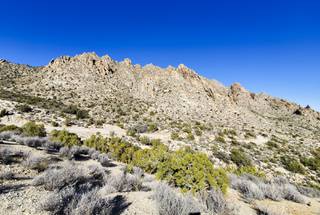South of Las Vegas off U.S. 95 — past Boulder City and its solar arrays, past the tiny town of Searchlight, past the privately owned community of Cal-Nev-Ari — lies a pathway to a place of spectacular natural splendor.
Travelers on Christmas Tree Pass Road, a dirt road that winds toward a towering mountain range, are likely to see people backpacking or gazing up at huge rocks stacked atop each other, as if a giant casually made his own cairn while hiking. This is a place of enormous spiritual significance for local Indigenous peoples, who are working with conservation groups to protect it from development.
Avi Kwa Ame, which is Mojave for Spirit Mountain, is part of the Newberry Mountains and is the center of 12 tribes’ creation stories. Tribes, conservation groups and activists are calling on the Biden administration to designate 380,000 acres of land in southwestern Nevada as the state’s fourth national monument to protect it from development.
The Fort Mojave tribe, for instance, originates from the mountain, where their Creator put them in order to steward and care for the land, said Taylor Patterson, executive director of Native Voters Alliance Nevada and member of the Avi Kwa Ame Coalition.
For other tribes, while not a part of their creation story, the mountain served as a place to gather sacred medicines and to trade with other tribes, Patterson said. The area is also part of the Salt Song Trail for Southern Paiute tribes, which tells the traditional life cycle of the Southern Paiute people, Patterson said.
“It was really a cultural site,” Patterson said.
The area is also home to Joshua trees — some of which are more than 900 years old — as well as wildlife like desert tortoises and big horned sheep.
In the late 1990s, the mountain and its surrounding 48,000 acres were designated as a traditional cultural property on the National Register of Historic Places, but it is still in danger of development. A couple of years ago, a company proposed using the area as a wind farm with a project known as the Crescent Peak Wind Project, but the proposals were denied, said Angelyn Tabalba, communications director for the Nevada Conservation League and Education Fund.
A national monument is a designation for public land established either by Congress or through presidential executive orders through the Antiquities Act of 1906. The designation would permanently protect important values including recreation, natural and cultural resources.
When the Crescent Peak Wind Project proposal was rejected, the Fort Mojave Indian Council passed a resolution in September 2019 and sent a letter to the Nevada congressional delegation requesting that the area be protected as a national monument. In 2020, national and local conservation groups launched a public awareness campaign to garner support.
Efforts to protect the area were renewed early this year when Crescent Peak Renewables LLC submitted another application to the Bureau of Land Management for a 308-megawatt wind farm called the Kulning Wind Energy Project, which would be located nine miles west of Searchlight.
City councils have announced their support to designate Avi Kwa Ame as a national monument. Boulder City Council unanimously passed a resolution in support as well as the Searchlight Town Advisory Board. And on Nov. 9, the Laughlin Town Advisory Board voted 3-1 to support the designation of Avi Kwa Ame National Monument.
Conservationists think they have a good chance, especially with Biden’s recent restorations of Utah’s Bears Ears and Grand Staircase Escalante as national monuments as well as with the passage of the federal 30 by 30 resolution, an initiative to conserve 30% of U.S. lands and waters by 2030, Tabalba said.
The designation will not only be important for outdoor recreation, such as for hiking, backpacking and four-wheeling, but it will also help support the nearby towns that are along the route to get to the monument, Tabalba said.
If it receives the national monument designation, the area will also receive better resources for more roads and signage to make it easier for people to access, said Maria-Teresa Liebermann-Parraga, deputy director of Battle Born Progress.
“A lot of folks don’t know that there is this great sacred place that you can go to at the tip of Southern Nevada,” Liebermann-Parraga said.
The national monument designation would also allow for greater flexibility in management than a national park, Patterson said. The coalition wants to make sure tribes would be able to co-manage the land.
“Avi Kwa Ame, our place of creation, is continually threatened,” said Fort Mojave Chairman Timothy Williams in a statement, “and we remain steadfast in protecting our sacred land. Fort Mojave looks forward to a day like today when we can come together and proclaim the Avi Kwa Ame National Monument.”
To sign a petition in support, go to honorspiritmountain.org.



